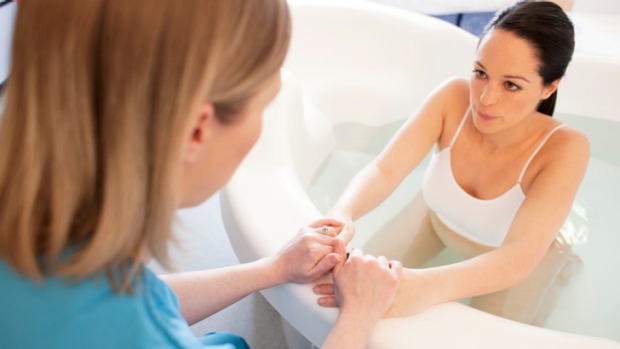
The safety of water births has been called into question after American experts released guidelines saying the practice had no proven benefits for women or their babies, and that it could even be potentially dangerous.
The Committee Opinion, released by the American Academy of Paediatrics and American College of Obstetricians and Gynaecologists, highlights cases of "rare but serious" problems including potentially lethal infections from contaminated water, serious haemorrhages from umbilical cord damage, and drownings.
The guidelines, which will be published in the April edition of US journal Obstetrics and Gynecology, conclude that women should not routinely be offered an underwater delivery, and that water births should be limited to those taking part in medical studies.
But according to the Australian College of Midwives, pregnant women hoping to have a water birth shouldn't change their plans.
"The reason there's not enough evidence of the level which would satisfy doctors about the safety of water births is because, as with home births, it is very difficult to conduct randomised clinical trials of women who give birth in water," the college's spokeswoman, Professor of Midwifery Hannah Dahlen says.
"That's just because of the very private nature of birth. A woman who wants to give birth in water will, but you can't force a woman to give birth in water if she doesn't want to."
Ms Dahlen says the US guidelines' "negative outcomes" are a collection of individual cases which did not paint a fair picture of the safety of water births for the majority of women who have low risk pregnancies.
She pointed to her own research, published in the Journal of Midwifery in 2012, which found no difference in major tearing and haemorrhage after delivery between women who gave birth in water and those who birthed in a semi-seated position.
That study, which looked at outcomes of 6144 Australian women over a 12-year period, also found that babies who were born in a semi-seated position had a much higher incidence of five-minute APGAR scores less than seven than those who were born in water. APGAR scores rate a newborn's health, and a score of less than seven at five minutes after birth shows medical intervention was needed to resuscitate the baby.
The attitude toward water births is much more accepting in the UK, where both The Royal College of Midwives and The Royal College of Obstetricians and Gynaecologists say healthy women with uncomplicated pregnancies should have the option of a water birth.
In Australia, an increasing number of hospitals are encouraging the use of water during labour and birth by including baths in delivery suites. In 2010, as part of their 'Towards Normal Birth' policy directive, NSW Health stated that by 2015 all women should receive information about the use of water immersion in labour and birth, and all maternity services should offer access to water immersion.
In releasing the US guidelines last week, Dr Jeffrey L Ecker said there was a difference in safety and benefit levels between labouring in water compared to giving birth while immersed.
"Labouring in water may offer some potential benefits, but delivering underwater does not seem to have clear advantages, and the risk of rare, but serious, consequences to a delivering baby's health is something women and providers should all be aware of,” he said.
The US guidelines come after a statement released by the Royal Australian and New Zealand College of Obstetricians in 2008 which raised similar safety concerns and said water births "cannot currently be favoured over conventional birth".
The RANZCOG statement warns that there is a low incidence of serious adverse events that don't occur often enough to take place in clinical studies, but that happen with "sufficient frequency and severity to achieve clinical importance".
"Complications that have been reported to occur in the setting of water birth include drowning, near drowning, respiratory problems, cord avulsion, and waterborne infections. In addition, management of some obstetric and neonatal emergencies cannot be completed adequately whilst a woman is immersed in water."
Despite these warnings, RANZCOG states that, where the facilities exist, women who have acknowledged the risks associated with water births and still want to go ahead with one "should be supported in their decision-making and given every opportunity to do so in best practice facilities attended by appropriately trained staff".
Professor Dahlen says that regardless of how they decide to give birth, labouring women should always heed the advice of their health professionals.
"If your midwife is telling you to get out of the water for some reason, then you should get out of the water,'' she says. "But for a low-risk pregnancy, if all goes to plan, there is no reason to not labour and give birth in the water."


Comments